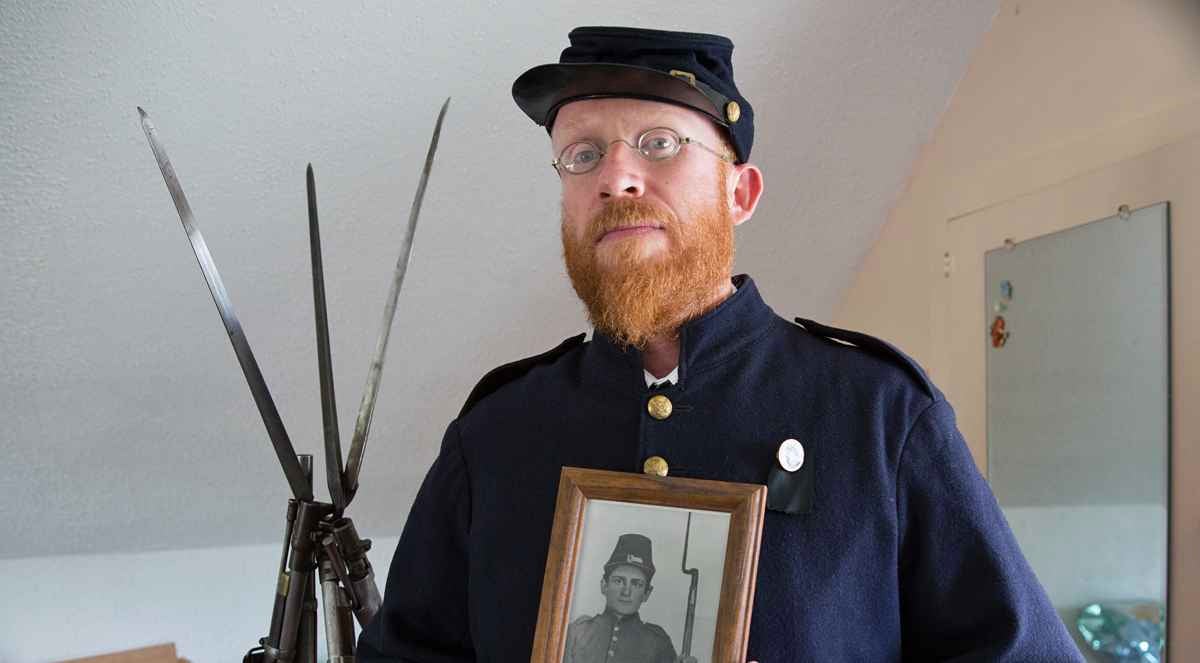In defense of war re-enactors
Listen
Civil war re-enactor preparing to take part in the 150th anniversary of the Battle of Gettysburg. He holds a photo of his great-great-great-grandfather who fought in the war. (Lindsay Lazarski/WHYY)
For the past 30 years, I’ve been urging my students to put themselves in the shoes of people who lived in the past. So why do we make fun of Americans who do that as a hobby?
I’m talking about military re-enactors like Eric Frein, the 31-year-old man suspected of killing a police officer and wounding another at a state police barracks in northeastern Pennsylvania last month. A few weeks into the manhunt for Frein, news organizations reported that he played a Serbian soldier—”Istocni Vuk,” he called himself—in a unit that re-creates Eastern European armies from the Cold War era.
Frein studied Serbian and Russian languages and even smoked Serbian cigarettes, as investigators discovered when they searched his home. They also believe that the skills Frein acquired in re-enactments might have helped him elude the hundreds of law enforcement officials who are looking for him.
And if you look at the blogosphere, you’ll see how this news changed the way we look at Eric Frein. He’s not just an anti-government extremist–as was reported earlier–but instead a “war nut,” one of those “losers” who spends his time and money pretending to be somebody else. But these guys can’t tell the difference between real and pretend, or so the argument goes. And that’s why Eric Frein mutated from a phony solider into an actual killer.
Nonsense. Unlike Frein, who was frequently out of work, most war re-enactors are law-abiding citizens holding down solidly middle-class jobs. And unlike the kooks of Internet caricature, they’re fully capable of separating fantasy from fact.
Like every good history teacher, though, they also understand that history is always–at some level–an act of imagination: to comprehend the past, we have to pretend we are there. That’s why classroom teachers often ask their students students to assume historical roles. A classic exercise is the recreation of the Versailles Peace Conference at the end of of World War One, with each student or group playing a different nation. Or we sometimes stage elections from the past, asking students to represent competing candidates.
That’s what military re-enactors do for wars, of course, but they typically play everyday soldiers rather than famous generals and politicians. So they also echo the post-1960s historical profession, which has emphasized “history from the bottom up”—that is, from the perspective of “regular” or “average” citizens—rather than from the top down. I’ve written five books, and every one of them draws from letters, diaries, and memoirs left behind by people you’ve probably never heard of.
But they’re largely unread, gathering dust on library shelves and remainder bins. The only people who buy my books are fellow historians and the occasional college student, who might be assigned one in a class. Most Americans want a more direct encounter with the past than a book can provide. So they visit museums and “living history” sites, where docents dress up in period costumes. And they also dress up themselves, as soldiers.
“The History Channel is great, and publications on the war are a wealth of information,” a World War II re-enactment unit declared on its Web page, “but once you put on sixty pounds of equipment, stand knee deep in muck, and enjoy bully beef out of the tin on a damp chilly morning, the pictures on TV and the text from a book don’t carry the weight they used to.”
Like Eric Frein, who participated in Vietnam War events as well as Eastern European ones, re-enactors often assume different identities at different times. The most controversial ones are the Civil War Confederate “rebel” and the Nazi-era German S.S. officer, which have each attracted a subset of rabid racists who embrace the philosophies—not just the uniforms–of the historical figures they represent.
But they’re the exceptions. Even in the North, twice as many Civil War re-enactors play Confederate as Union soldiers; they’re trying to understand the lives and challenges of their subjects, not to defend the Southern point of view. And World War II re-enactors work hard to “weed out the political nutzos . . . on the German side,” as one participant told historian Jenny Thompson. Neo-Nazis and others who join reenactments for “political reasons” eventually leave the hobby, he added, because they don’t find compatriots there.
As best we can tell, Eric Frein kept his political views to himself. His fellow re-enactors don’t seem to have known about his anti-government extremism or his heinous plans. These pretend-soldiers shouldn’t be blamed for Frein’s real-life crime, any more than a racial or ethnic group should be held responsible for a violent act by one of its members. And if you pretend otherwise, you’re caught up in a fantasy of your own.
WHYY is your source for fact-based, in-depth journalism and information. As a nonprofit organization, we rely on financial support from readers like you. Please give today.

